Yeti’s SB165 Is a Big Bike for Big Mountain Riding
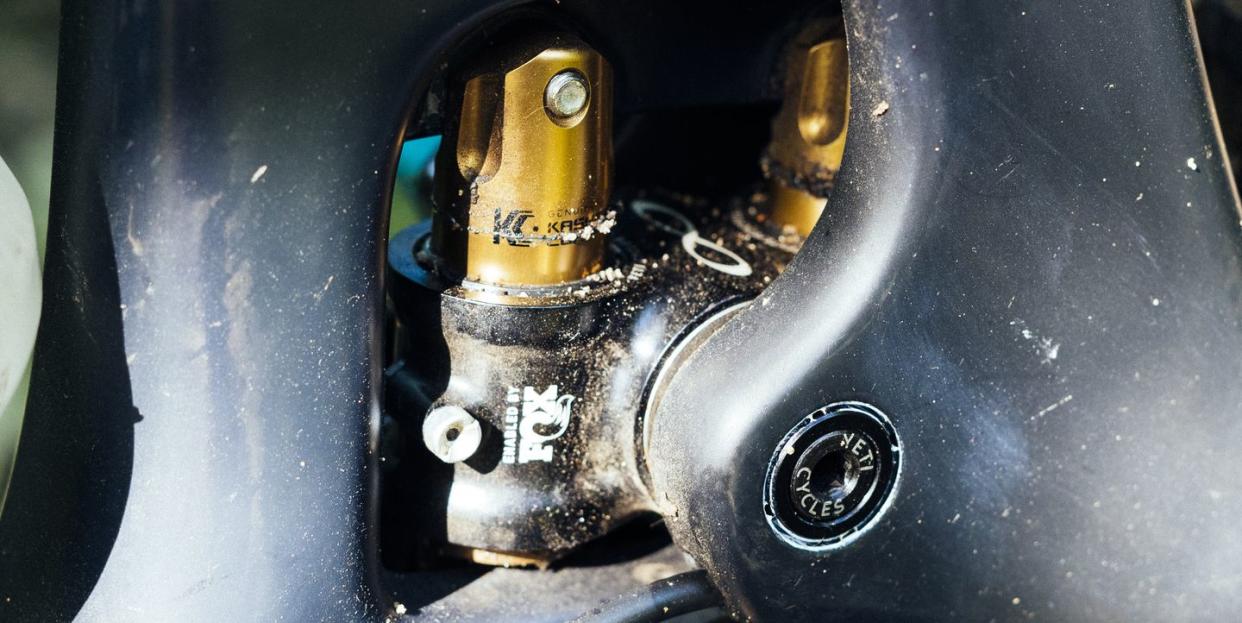
On paper, Yeti's new SB165 looks like an enduro race bike. It has a lot of travel—165mm with 180mm fork—and long, low, and slack geometry (its 63.5 degree head tube angle is about the same as a Santa Cruz V10 downhill race bike). The SB165 effectively replaces the SB6 in Yeti's line, a bike extensively raced by Yeti's superstar enduro racer Richie Rude, and much of the imagery accompanying the SB165 launch features Rude.
But according to Yeti's president Chris Conroy, the SB165 isn't an enduro race bike; it's something else.
Yeti breaks its bikes into two categories—race and rip. Race bikes are for riders who want to take the fastest way between two points. In Yeti's current line, the race bikes are the SB1oo, and the SB150. Yeti's rip bikes are built for riders who prefer to take a more playful down the mountain. The SB130 is a rip bike, as is the new SB165.
"The SB165 is made to handle the toughest, steepest terrain, which might not be inside the tape," said Controy, adding that it's designed for taking the most fun way down the mountain, which isn't always the same as the fastest way down. However, Conroy hinted that the SB165 might see race duty if the terrain calls for it.
What’s New
Spiritually, the SB165 is the successor to Yeti’s SB6 enduro bike, which launched in 2014 and was the oldest bike in Yeti’s line.
But the SB165 is so much bigger, longer, slacker than the SB6 it’s a completely different beast. All they have in common is the 27.5 in. wheel size.
The 165 shares the profile that Yeti unveiled in the SB100, and has since been incorporated into every model save the SB5 (there’s your hint if you’re wondering what the next new Yeti model might be). The tubes are straighter and crisper than Yeti’s previous models, and there’s room for a water bottle in the main triangle. The SB165 has more travel (165mm of course) and comes with a 180mm fork (the SB6 had 157mm travel with a 170mm fork).
Reach jumps significantly (reach size medium SB165, 460.1mm; size medium SB6, 420.4mm), the 165’s head angle is 63.5 (with a 37.5mm offset fork) and seat angle is 77 degrees (SB6, 65.1 and 73.1 degrees). The SB165’s chainstays are 433mm (SB6, 442mm), and even though the SB165 has more travel at both ends, it’s bottom bracket is lower than the SB6’s (344.9 VS. 348mm).
Those geometry numbers push the SB165 to the more-progressive end of its competitive set. It’s not longer/slacker/lower/steeper than everything out there (see matrix), but it is more so than most. For now, anyway.
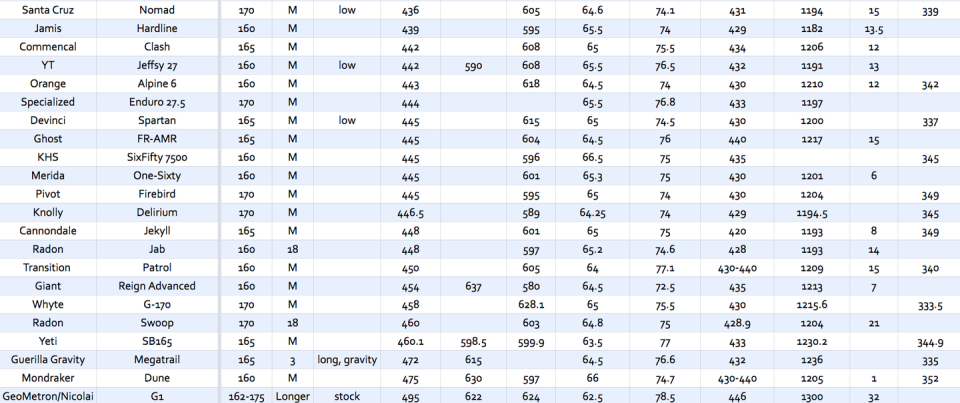
The SB165 employs Yeti’s well-regarded Switch Infinity suspension like the rest of the brand’s line. But while all other Yeti’s are optimized for air shocks, this bike gets a highly progressive—27.5 percent— coil-spring-optimized tune. It’s the most progressive shock rate of any Yeti.
"27.5-percent progression refers to the percentage change of leverage rate from the extended state to the compressed state, " Peter Zawistowski, Yeti's director of engineering., told Bicycling. For comparison, here are the progression rates of the other Yeti models SB100, 10-percent; SB130, 12-percent; SB150, 15-percent. These bikes have a lower progression rate because they are designed for an air shock.
"More progression is not always better," said Zawistowski, "We want to be sure there is great small bump sensitivity, mid-stroke support, and bottom out resistance, while at the same time all travel is utilized when needed. The SB165’s significantly higher leverage rate progression percentage is designed specifically for the linear spring rate of a coil shock, or a large volume [air] shock like the Float X2."
All complete SB165s and frames come with a coil-spring shock—a Fox DHX2 or Vanilla. The frame is compatible with some air shocks—with large linear springs like the Fox Float X2—for riders who want to cut a bit of weight, or prefer the greater adjustability of an air spring.
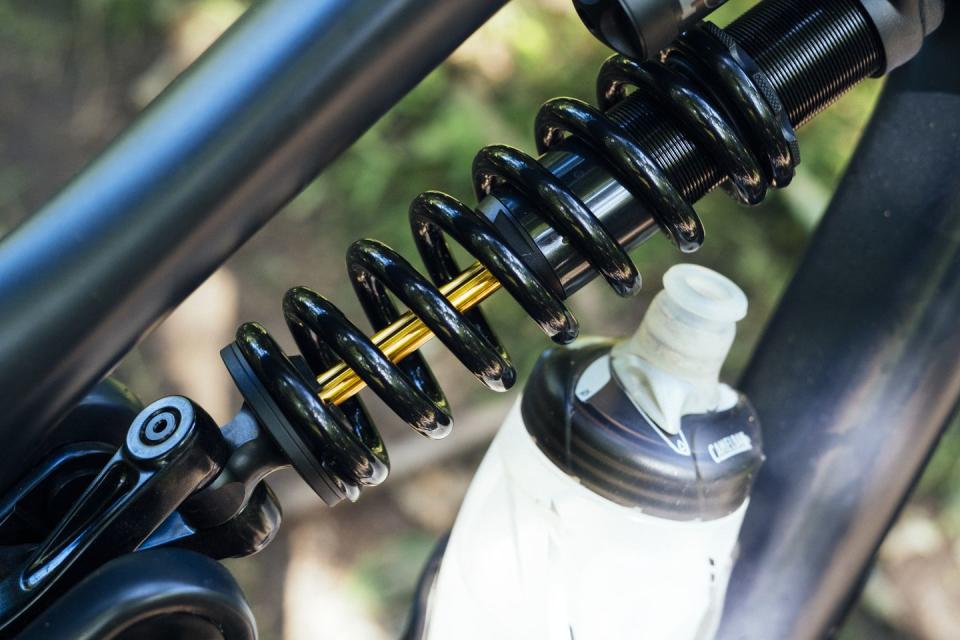
Yeti offers the SB165 frame in carbon only, and in two grades: the lighter and higher end Turq series, and the more affordable but heavier (about 200 grams) Carbon series. Stiffness is the same for both frames, and both SB165 frames are tested to, and pass, Yeti’s “DH” durability standard, which is more rigorous and punishing that the standard it uses for its trail bikes.
The SB165 Family
Yeti sells the SB165 as a frame only (Turq level with Fox Factory DHX2 shock) for $3,999. That’s one of the most expensive mountain bike frames in the world.
Five complete builds are offered. All bikes get Fox suspension and dropper post, 1x12 drivetrains, DT-Swiss wheels, Maxxis Minion DHF/DHR II tires, OneUp bash guide, and WTB saddle.
Complete bikes start off with the SB165 C1 ($5,599) and C2 ($6,199) which use the lower grade (heavier) carbon frame.
There are three builds using the higher end Turq level frames, priced at $7,199, $7,699 (the model reviewed here), and $8,799. The T1 ($7,199) is the only bike with Shimano drivetrain and brakes; it gets the new XT group. Two upgrades are offered: a SRAM AXS wireless derailleur and shifter (for SRAM-equipped models only) , and a DT-Swiss wheelset with carbon rims. The price of the upgrade is different for every bike model.
Ride Impressions
The SB165 was designed for and with professional athletes like Richie Rude, Yeti’s superstar enduro racer. So we thought some pro feedback would be interesting, so we dropped the SB165 with a local professional enduro racer to get his take on the bike.
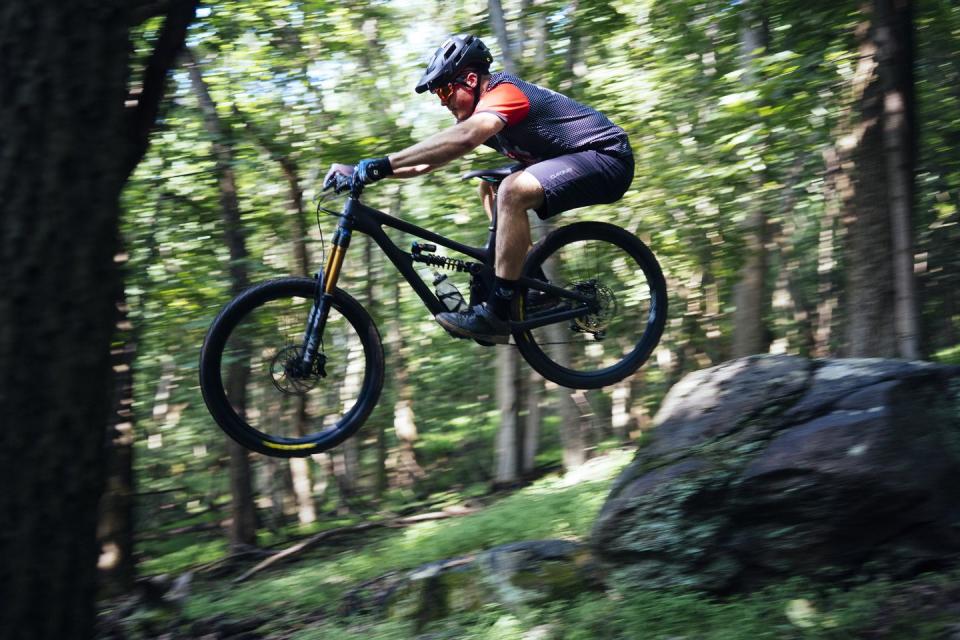
“The back end of the bike was extremely responsive to my demands,” he said, adding, “The long travel up front gave me extreme confidence in tight steep turns; just required a slight pointing of the hips is all it took for the results I wanted. In high speed flat turns the rear shock maintained traction that left a smile on my face every time. It actually required me to bump my rear tire pressure up by two psi, otherwise I would continuously roll tires off of the rim. This may be due to the stock tires not having a downhill casing.”
Our Racer X said that he would “a hundred percent” put a downhill-casing rear tire on the SB165. The tires Yeti chose for its stock build kit are lighter and roll more quickly than a DH casing tire and are probably durable enough if you plan to use the SB165 as a trail bike. But if you’re an aggressive and fast and plan to do park riding or enduro racing, you’ll want beefier tires.
The SB165 is a very slack and very big gravity-oriented bike. So, it’s not too surprising that it struggles at technical climbing. “The front end was all over the place. Climbing switchbacked uphills was like watching your dog run towards traffic. Stability was almost within reach, yet you felt like the dog was going to step of the curb into traffic at any moment,” said Racer X.
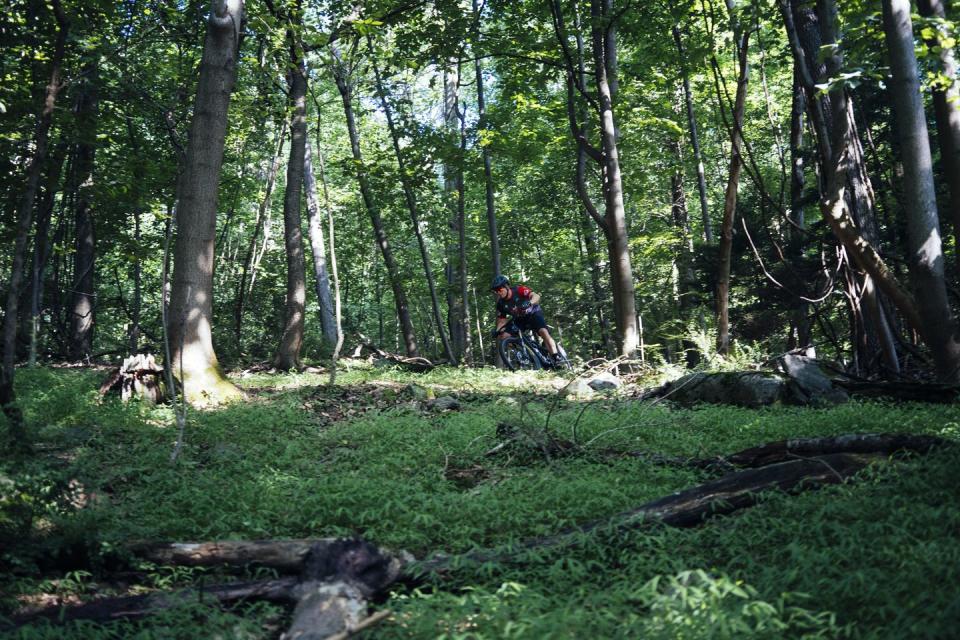
And it is not just uphills that are a challenge. The SB165 needs speed to work; anytime the speed drops, it starts to feel drunk and imprecise, “Flat, slow, 90 degree turns, front end of the bike wants to run away from you. They need to be anticipated in advance or you’ll end up closer to the edge of the trail than you like.”
Still our Racer X praised the efficiency of the SB165’s suspension when climbing, “The shock is very active uphill with very little pedal bob, definitely a pleasant surprise. In steep straight rocky climbs, the bike ascended surprising well.”
Considering the SB165 in total, Racer X stated that it’s a bike that is surprisingly efficient and descends incredibly well, but it’s how a rider accesses those descents that’s the deciding factor. Riders that mostly shuttle, or have access to a lift, or ride up double tracks or roads to the descents are the best audience for this bike. But if you’re forced to climb slow, tight, and technical trails to reach those descents, “this is going to be too much bike,” he said.
In conclusion our Racer X said, “If I decided tomorrow that I was going to race big mountain enduros, this would be my bike of choice without a doubt. The traction and responsiveness that this bike provides to an individual that likes to pin it is unbelievable.” Considering what the SB165 is supposed to be, that means it’s just about perfect.
Frame: Carbon, 165mm travel
Fork: Fox Factory 36 Grip 2, 180mm travel
Drivetrain: SRAM X01 Eagle
Wheels: DT-Swiss EX1700, aluminum rims
Crank: SRAM X1 Dub, 170mm
Chainring: 30t
Brakes and Rotors: SRAM Code RSC, 200mm rotors
Tires: Maxxis Minion DHF EXO+ 2.5in. (front), DHR II EXO+ 2.3 in. (rear)
Tire clearance: 2.6 in.
Handlebar: Yeti Carbon 35, 800mm
Dropper: Fox Transfer, S: 125mm, M: 150mm, L-XL: 175mm
You Might Also Like

